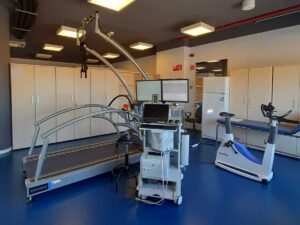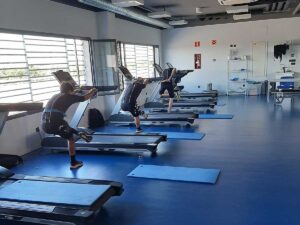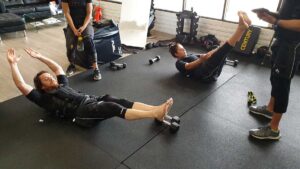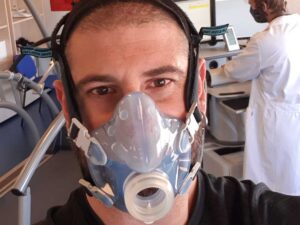As we already know, physical training is very important to achieve important benefits in body composition. Concurrent training where resistance training and cardio are combined induces a decrease in body fat and increases muscle mass in sedentary men and women. In addition, resistance resistance training was found in one study to improve sedentary bone mineral density in men [2] and women [3].
On the other hand, high intensity interval training (HIIT) is more efficient in time than continuous training of moderate intensity to achieve improvements in body composition. Despite all of the above, new effective training technologies are emerging such as whole body electrostimulation (WB-EMS). WB-EMS training has been shown in various studies to help decrease body fat and increase muscle mass in sedentary older men and women with sarcopenic obesity (with loss of muscle mass), in runners, and in healthy men and women of middle age [4,5,6,7,8,9,10,11,12,13].
Therefore this study aimed to investigate the effects of different training programs (a) A concurrent training based on the WHO (World Health Organization) recommendation for physical activity (PAR group), b) HIIT group, c ) HIIT group with WB-EMS) on body composition parameters in sedentary middle-aged adults.
For this study 89 middle-aged adults between 45-65 years (52.7% women) were assigned. Participants were randomly assigned into four groups: a) Control group (no exercise), b) PAR group, c) HIIT group and d) WB-EMS group.
Regarding training programs, the PAR group carried out concurrent training based on the minimum physical activity recommended by the WHO. The training frequency was 3 sessions a week for 12 weeks. The training volume was 150 min / week at 60% -65% of the reserve heart rate in cardio training. For this, a treadmill, an ergometer and an elliptical were used. For resistance resistance training the training volume was 60 min / week with an intensity of 40% -50% of a maximum repetition. Machines and weights (squats, bench press, deadlift, or pull-ups) were used for strength resistance training.
HIIT training was performed with short, intermittent intervals of high intensity interspersed with passive rest periods or with low intensity exercises. Participants performed two types of training protocol alternately 2 days / week for 12 weeks: a) HIIT with long intervals (session type A) and b) HIIT with short intervals (session type B). The training volume was 40-65 min / week and the training intensity was> 95% of the maximum oxygen consumption in the type A session, and an effort perception scale (RPE) 6-9 out of 10 in the session type B. The type A session was performed on a treadmill with a personalized incline, and in the type B session 8 strength exercises were performed (squat, deadlift, side plank, push up, horizontal row, …) in circuit.
HIIT training with WB-EMS followed the same training program as the HIIT group to verify whether WB-EMS induces an additional effect on body composition parameters. For this training program, the Wiemspro (Málaga, Spain) device with a bipolar, symmetric and rectangular wave type with frequency parameters between 15 and 20 Hz in the type A session and 35-75 Hz in the session was used. type B. Regarding the intensity, it was 100 milliamps in the type A session and 80 milliamps in the type B session. The pulse width was between 200-400 µs (Quadriceps / ischium = 400 µs, Gluteal = 350 µs, abdomen = 300 µs, dorsal = 250 µs, trapezius = 200 µs, pectoral = 200 µs and arms = 200 µs). And finally, the electrical impulse work cycle was continuous in the type A session and in the type B session the percentage of the electrical impulse was between 50% -63%.
All sessions began with a dynamic warm-up of general mobility and a return to calm with active global stretches.
Analyzing the results, the body mass index (BMI) decreased in the PAR group compared to the HIIT group and the WB-EMS group. Regarding the waist circumference (WC) it was significantly lower in the HIIT and WB-EMS groups compared to the control group. Body fat, body fat percentage, body fat index, and visceral fat decreased significantly in the PAR group and in the WB-EMS group compared to the control group. On the other hand, muscle mass increased significantly in the HIIT group and in the WB-EMS group compared to the control group. And the muscle mass index was significantly increased in the WB-EMS group compared to the PAR group and the control group. Also, the bone mineral content increased significantly in the WB-EMS group compared to the control group.
Taking into account the results found in this study, we can conclude that a concurrent training based on the WHO recommendation for physical activity (PAR group), a HIIT training and a HIIT training with WB-EMS can induce a decrease in body fat. Also, only HIIT training and HIIT training with WB-EMS can induce an increase in muscle mass in sedentary middle-aged adults. Finally, HIIT training with WB-EMS can improve bone mineral content in sedentary middle-aged adults. One fact to reflect is that with HIIT training together with WB-EMS the best results were obtained in all the mentioned parameters.
Therefore, we can say that HIIT training with WB-EMS is very effective for improving body composition in sedentary middle-aged people.
Bibliography:
- Amaro-Gahete, Francisco J. De-la-O, Alejandro Jurado-Fasoli, Lucas Ruiz, Jonatan R. Castillo, Manuel J. Gutiérrez, Ángel. (2019). Effects of different exercise training programs on body composition: A randomized control trial. Scandinavian Journal of Medicine and Science in Sports, 29, 968-979.
- Michell V, Samaria C, Júnior Rudy N, Danyela V, Dantas E. Effects of a concurrent physical exercise program on aerobic power and body composition in adults. J Sports Med Phys Fitness. 2014;54:441‐446.
- Ferreira FC, de Medeiros AI, Nicioli C, et al. Circuit resistance training in sedentary women: body composition and serum cytokine levels. Appl Physiol Nutr Metab. 2010;35:163‐171.
- Kemmler W, Kohl M, Freiberger E, Sieber C, Von Stengel S. Effect of whole‐body electromyostimulation and / or protein supplementation on obesity and cardiometabolic risk in older men with sarcopenic obesity: the randomized controlled FranSO trial. BMC Geriatr. 2018;18:1‐12.
- Kemmler W, Grimm A, Bebenek M, Kohl M, von Stengel S. Effects of combined whole‐body electromyostimulation and protein supplementation on local and overall muscle/fat distribution in older men with sarcopenic obesity: the randomized controlled Franconia Sarcopenic Obesity (FranSO) Study. Calcif Tissue Int. 2018;103:1‐12.
- Amaro‐Gahete D, Robles‐González L, Castillo M, Gutierrez A. Impact of two whole‐body electromyostimulation training modalities on body composition in recreational runners during endurance training cessation. Rev Int Cienc Deporte. 2018;53:205‐218.
- Kemmler W, Weissenfels A, Teschler M, et al. Whole‐body elec- tromyostimulation and protein supplementation favorably affect sarcopenic obesity in community‐dwelling older men at risk: the randomized controlled FranSO study. Clin Interv Aging. 2017;12:1503‐1513.
- Kemmler W, Teschler M, Weißenfels A, et al. Effects of whole‐ body electromyostimulation versus high‐intensity resistance exercise on body composition and. strength: a randomized controlled study. Evid Based Complement Altern Med. 2016;3: 44‐55.
- Kemmler W, Teschler M, Weissenfels A, et al. Whole‐body electromyostimulation to fight sarcopenic obesity in community‐dwelling older women at risk. Results of the randomized controlled FORMOsA‐sarcopenic obesity study. Osteoporos Int. 2016;27:3261‐3270.
- Von Stengel S, Bebenek M, Engelke K, Kemmler W. Whole‐body electromyostimulation to fight osteopenia in elderly females: the randomized controlled training and electrostimulation trial (TEST‐ III). J Osteoporos. 2015;11:1‐7.
- Von Stengel S, Bebenek M, Engelke K, Kemmler W. Whole‐body electromyostimulation to fight osteopenia in elderly females: the randomized controlled training and electrostimulation trial (TEST‐ III). J Osteoporos. 2015;11:1‐7.
- Kemmler W, von Stengel S. Whole‐body electromyostimulation as a means to impact muscle mass and abdominal body fat in lean, sedentary, older female adults: subanalysis of the TEST‐III trial. Clin Interv Aging. 2013;8:1353‐1364.
- Kemmler W, Schliffka R, Mayhew JL, von Stengel S. Effects of whole‐body electromyostimulation on resting metabolic rate, body composition, and maximum strength in postmenopausal women: the Training and ElectroStimulation Trial. J Strength Cond Res. 2010;24:1880‐1887.







